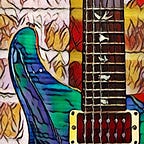Building a Recording Studio — Part 3
Part 3: Counting the Loud
Construction has begun on the studio. Woo! The garage door has been removed replaced with a wall and the framing is now in place for the walls and the ceilings. Standing in the space I can start to get a feel for it more than when there was just tape on the ground.
If you look in the plans from Part 2 in this series, you’ll see that there’s a strange bump along the top wall.
We need to add a post to hold up the beam that will be supporting the upper ceiling and to make sure that it didn’t touch the inner walls, they would pop out a bit. Well the actual post doesn’t need to be as big as originally thought and it is slightly inset from the studs so we can either go over it as long as we avoid any nails going into it or (more likely) we can get away with a smaller bump so we can ensure there’s still room for the proper insulation and air gap.
The inside wall still needs to connect to something on the top. To minimize any transfer of vibration, we’ve added Auralex Acoustics U-Boat Floor Floaters on the top which are made with a vibration-isolating rubber. While originally intended for floating a framed floor above concrete, they should work here to dampen the vibration before it reaches the member attached to the joists. We are not floating the beams on the floor since concrete is a great absorber of sound (lots of mass) and we don’t have anyone below us.
Getting a Baseline Noise Reading
Before we go any farther, though, I wanted to get a baseline for how much sound escapes from the garage when there is no insulation or drywall in place. As the studio is built, I can run these tests again to see how we’re doing at isolating sound made inside. I brought in a small pair of powered monitors and hooked up my phone to them and ran 3 tests from a number of positions around the garage and near the house. I used an inexpensive decibel meter to capture the average sound level from 6 locations:
- 3 feet directly in front of the speakers
- At the far wall of the studio where the door to the outside will be placed
- On three sides of the garage about 3 feet from the outside wall
- On a railing closer to the house which is about 40 feet from the garage to get a sense of how loud it will be when someone is on the back deck of the house. This is a reasonable number for what the neighbors would hear as well
Ambient Sound Test
First I went to those locations to capture the ambient sound level with nothing playing from the speakers. This is basically the perfect value if we were to completely isolate the studio. All you would hear outside is the ambient noise of wind, birds, etc. Most of the time, the outside readings were between 42.3dB and 44dB outside of the garage and about 40dB inside (the lowest reading I got in ambient sound was about 37.8dB inside when all of the neighborhood sounds quieted down).
Pink Noise Test
Next I cranked up the speakers and played a sample of pink noise. Pink noise is best for this measurement because it will have more power in lower frequencies which better reflects what music transfer will be like. The measurements from just in front of the speaker came in at 101.5dB. Yeah — it was pretty loud. At the far wall inside the garage it barely dropped to 99.6dB which is expected given that there’s not much between the speakers and that location. Outside of the garage the readings were from 73.2dB to 75dB which is still pretty loud. Not painful but unmistakably loud noise coming from the garage. At the house, the reading was 69.3dB.
Tom Sawyer Test
Finally I played Tom Sawyer by Rush. I wanted to get a sense of how actual music sounded in these locations. While the decibel ratings didn’t vary a lot, my perception of the loudness did as I could hear the music perfectly clearly from all of the locations. As in the case of the Pink Noise test, the sound in front of the speakers was 101.4dB and the sound at the far wall was little diminished. Outside, the readings varied from 71.9dB to 74.5dB. These number changed a lot depending on what part of the song was playing, it was generally louder during the singing parts. At the house, I measured just 52.6 dB which is quieter than the sound of a passing car from the same location, but the music was much harder to ignore.
As expected, my air drumming didn’t add to the recorded levels.
So now we have the baseline values for sound exiting the garage when we have done no isolation work. The Tom Sawyer Test is actually a great indicator for how much work we have cut out in front of us. It didn’t take much music getting out of the garage to be noticeable though to be fair, I will rarely be working at 101dB. The ultimate test of the sound isolation work will be when I run these tests again and compare the values.
Stay tuned…
